Tidal Stream, Wave Energy + Creative Imagination

In this fourth episode of the Gifts from God series, I’ll introduce two exciting pioneers of tidal stream and wave energy. The first is Orbital Marine Power, another Scottish tidal stream innovator, and the second is ZOEX Power, a wave energy innovator.
Muddled, well-intentioned thinking misses the opportunity for leadership and growth
Before I dig into their details, I can’t help thinking that with all the arguments for and against the UK’s net zero policies, the voice of tidal stream and wave energy is seldom heard. It seems to me that there is a lack of joined-up thinking in the current government. On the one hand, we hear that growth is the number one government priority. On the other hand, the current energy policy, with its over-reliance on fossil fuel imports at the expense of the North Sea, means that the government denies access to UK businesses to cheaper, home-grown energy during the transition years of this decade—a case of purist net-zero thinking at the expense of the energy needed to drive growth.
While Miliband fixates on unreliable solar and wind energy, the opportunity to increase energy resilience by incorporating tidal stream and wave energy into the mix and fostering a leadership position in these two complementary sources is negligently overlooked. While I applaud the intentions behind the drive to net zero, I cannot ignore the myopic and disjointed thinking behind the current strategy outlined in the Clean Energy Industries Sector Plan published in June 2025.¹ There is simply no mention of either tidal stream or wave energy. Fusion gets a look in, but that isn’t expected to be viable until mid-century at the earliest.
I can only hope that the Marine Energy Taskforce (MET), sponsored by The Crown Estate and including Andrew Scott, Simon Forest, CEOs of Orbital Marine Power and Nova Innovation, respectively, and Anders Jansson, Head of Business Development at CorPower Ocean, will overcome Miliband’s energy myopia.
As I stated in the first episode, Ocean Energy Systems predicted that tidal and wave energy will become cost-competitive by 2030, generating 680,000 jobs and $340 billion in gross value added (GVA) globally by 2050.²
The UK government’s own calculations (2013) estimate that tidal stream and wave energy could contribute 20% of the UK’s current electricity demand by 2050, acknowledging that the UK is currently in a leadership position.
The UK government’s own calculations (2013) estimate that tidal stream and wave energy could contribute 20% of the UK’s current electricity demand by 2050, acknowledging that the UK is currently in a leadership position.
And, finally, Supergen ORE Hub and the Policy Innovation Group at the University of Edinburgh believe tidal and wave energy could generate £50 billion for the UK’s economy, create 90,000 jobs and enable the UK to take a leading position in ocean energy.³
Wake up, Miliband, let’s not squander this position.
Wake up, Miliband, let’s not squander this position.
Hopefully, pioneers such as Orbital Marine Power and ZOEX Power will capture the imaginations of the public and gain the moral support they need from our more influential media. Let’s now take a closer look at them.
Orbital Marine Power leading the tidal stream wave
Background
Scotrenewables Tidal Power, the precursor to [Orbital Marine Power,](https://www.orbitalmarine.com/) was founded in 2002 by Barry Johnston to develop floating tidal stream turbines. As a native of Orkney, he was keenly aware of the tidal power of the sea. He followed up his first degree in Offshore engineering at Heriot-Watt University by completing a PhD in marine renewables at the Orkney Campus of the same university. Johnston realised that to be successful, any design must work with the nature of the sea, not against it. Opting for a floating turbine anchored to the sea floor rather than attempting to build an underwater wind turbine fixed to the floor like a concrete tower would prove less expensive and much easier to maintain. Scotrenewables was rebranded Orbital Marine Power in 2018, under the leadership of Andrew Scott, an experienced engineer, formerly of Pelamis Wave Power, which collapsed in 2014.
Evolution of tidal stream turbines from 2010 to 2025 - increased power, practicality and reduced costs
Orbital’s current turbine, the O2, is an eye-catching, monumental feat of innovative engineering. It didn’t happen overnight, but rather through over two decades of trial, persistence, and creative imagination.
The SR250 prototype scores a world’s first and validates the design direction
Scotrenewables’ prototype, the SR250, was constructed at Harland & Wolf, Belfast, in 2010. Weighing in at 100 tonnes, it had 250kW twin contra-rotating, 8-metre-diameter, two-bladed rotors. It was towed to the EMEC Fall of Warness tidal test site in early 2011, reaching a peak output of 273kW, surpassing its design specification. Not only was the SR250 the world’s largest floating turbine at the time, but it was also the first to be connected to the grid in April 2012. The following year, in April, it became only the second device to complete EMEC’s Performance Assessment over six weeks of continuous use, confirming its power curve in a variety of tidal conditions. It has proven its reliability with over 4,000 hours of operation, without any failures or safety issues. The testing programme was completed in 2013, while the company developed the next model, the SR2000.
The SR2000 brings increased power and another world’s first
Supported by long-standing investors: ABB, the Scottish government’s Renewable Energy Investment Fund, DP Energy, Fred. Olsen Group and Total New Energies, with over £25 million of investment to date, SR2000 was built in 2012. Again, Harland & Wolf provided the primary construction muscle. Weighing in at 550 tonnes and with a 63 metre hull and giant 16 metre diameter rotors, this floating behemoth became the world’s most powerful tidal stream turbine at 2MW, producing more than 3GWh of electricity in the 12-month testing programme. It generated more power than the combined wave and tidal sectors had created in the 12 years preceding it.
A highly collaborative venture
Other constructors involved included the Texo Group of Dundee, which built the turbines, the hull by Grey Fabrication in Cupar, Fife, the four composite blades by AC Marine & Composites in Gosport, Hampshire, and the grit-blasting with around four tonnes of paint to protect it from the elements by BROL-Coat Ltd of Montrose.
Floating advantages and rugged design come to the fore
The floating platform proved easy to tow without the need for any specialised equipment. Its rugged design ensured it worked in wave depths of 6.6 feet, or at reduced power up to 11 feet. It first exported power in 2016 and was tested successfully until September 2018.
Personnel changes at the top and a rebranding
In 2017, Andrew Scott joined the company as CEO. In 2018, Scotrenewables rebranded as Orbital Marine Power. The name change reflected the focus on tidal stream energy and was inspired by the moon’s orbital cycle that creates the tides. It also presaged the next generation of floating turbine, the Orbital O2.⁴
The Orbital O2 and O2-X larger and more powerful
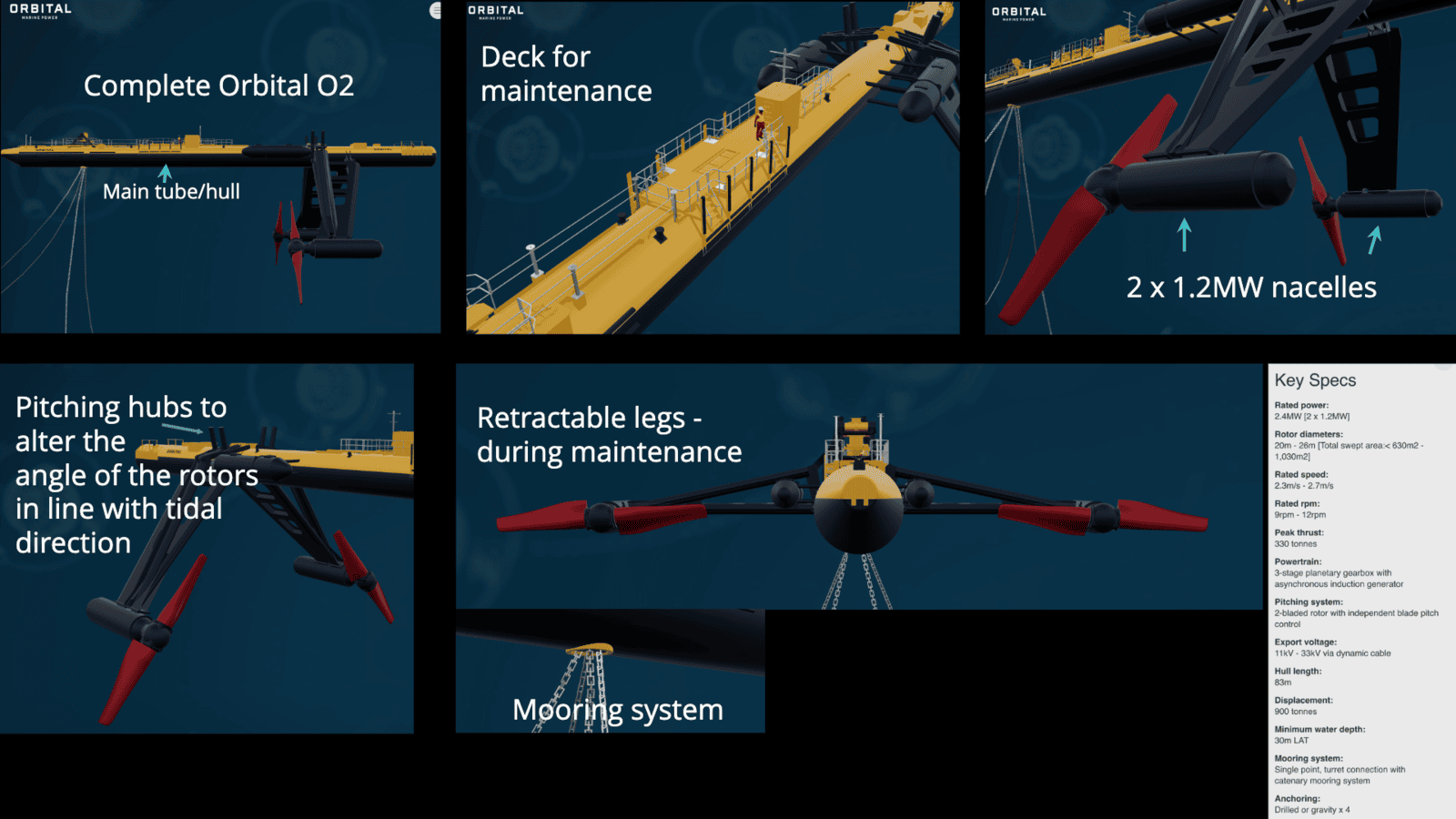
Figure 1 provides an image of the Orbital O2-X model, along with an outline of its different components. The company has developed a compelling video that offers an excellent overview of Orbital Marine’s purpose, evolution, and a well-articulated explanation of how the O2 works, along with a sense of its size and advantages. Andrew Scott knows how to pitch! Take a look. Picture a jumbo jet floating on the surface, and you’ll get a sense of the scale of the O2-X model. The Orbital O2 was launched from the port of Dundee on 22nd April 2021.
Size matters
The Orbital O2 has been exporting low-carbon electricity to the UK grid since July 2021. The O2, the world’s most powerful tidal turbine, is a 74m long floating superstructure, supporting two 1 MW turbines at either side for a nameplate power output of 2MW, at a tidal current speed of 2.5 m/s. With a rotor diameter of 20m, it has a 600-square-metre rotor area. To minimise towing costs, the turbine can be serviced by locally available vessels, despite its enormous size. Then it is moored by a four-anchor mooring system with chains strong enough to lift 50 double-decker buses. The two nacelles, which support the hub carrying the two turbine blades, house the components of the power take-off and gearbox. They can be easily replaced or overhauled as part of a maintenance schedule, and are large enough for easy inspection by engineers.
Major milestones and pipeline for the future
Figure 2 provides an outline of Orbital’s history and significant projects that are likely to take the company through the end of the decade. While Orbital cut its teeth, proving its technology and ability to continuously increase the power of its turbines at the EMEC test site over the last decade, it has gained international credibility and attracted significant investment beyond public sector grants.
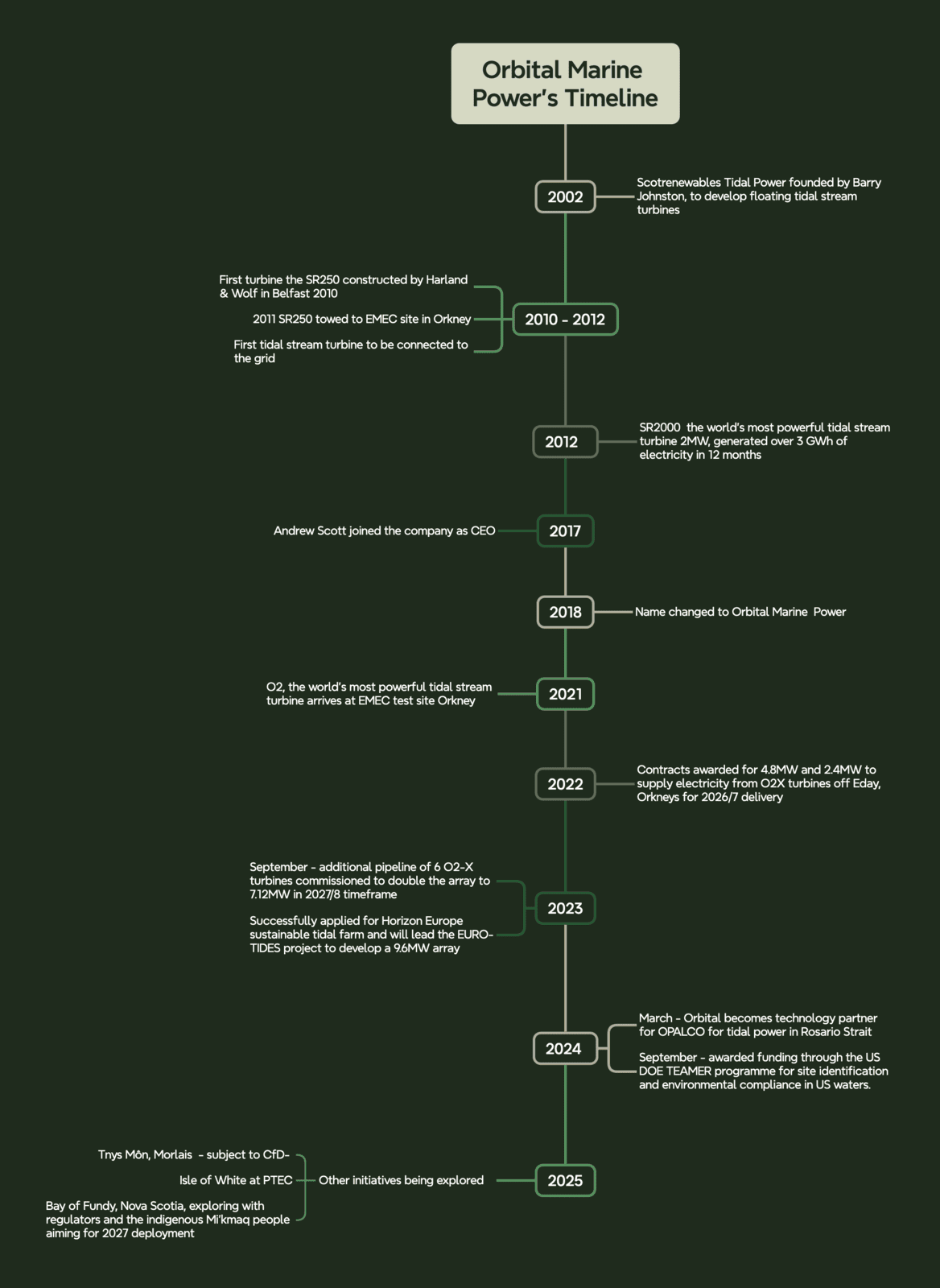
The SR250 and SR2000 turbines provided the proving ground for floating tidal turbine technology. With the launch of the much larger and more powerful Orbital O2 and plans for their next-generation O2-X turbine, the company has entered the commercialisation phase of its evolution.
In 2022, contracts were awarded for 4.8MW and 2.4MW O2-X turbines to supply electricity to the grid off Eday in the Orkneys for delivery in 2026/7. The following year, a further six O2-X turbines were commissioned to double the existing array and deliver 7.12MW for delivery in 2027/8.
Expanding into the US and Canada is on the horizon
In 2024, Orbital became the preferred technology partner for the Orcas Power and Light Cooperative (OPALCO), San Juan County, Washington, for tidal power in the Rosario Strait. In 2018, OPALCO initiated a search for alternative clean energy sources from the powerful tides in the straits. In 2021, Orbital received grants from the US Department of Energy to complete site and engineering assessments. OPALCO conducted environmental studies, and an MOU was signed with Orbital the same year. Since then, and under President Trump, there are concerns that further grants may not be forthcoming; however, Orbital and OPALCO are hopeful that the US Department of Energy Testing Expertise and Access to Marine Energy Research (TEAMER) will support the tidal project, which will also bring turbine manufacturing jobs to the US.⁵
Bay of Fundy, Nova Scotia, could significantly boost Orbital’s global presence
The Bay of Fundy is the Mount Everest of tidal energy. The world’s highest tides are found in the Bay of Fundy, ranging from 11ft along the southwest shore of Nova Scotia to 53ft at the head of the Bay, in the Minas Basin.⁶
However, the Bay of Fundy has proven to be a graveyard for tidal turbine companies.
However, the Bay of Fundy has proven to be a graveyard for tidal turbine companies.
- In 2018, Open Hydro’s turbine failed to withstand the peak tide conditions equivalent to a category four hurricane. Its turbine remains at the bottom of the Minas Passage after the firm went bankrupt.
- Scottish tidal company Sustainable Marine Energy Ltd went bust in 2023 as it could not get past the regulatory authorities at Fisheries and Oceans Canada, despite no evidence that fisheries would suffer.
- In 2024, Occurrent filed for bankruptcy as it could not cover its bills with suppliers. Worse, its moorings, which consisted of four rail cars filled with concrete, were left stranded at the bottom of the bay, increasing the friction between the Bay of Fundy Inshore Fishermen’s Association and the Fundy Ocean Research Centre for Energy.
Despite this catalogue of disasters and regulatory hurdles, Orbital Marine, in partnership with Eauclaire Tidal, a group of tidal energy professionals, has applied to Fisheries and Oceans Canada for a review of its project to test an O2-X at the FORCE test site. The company is currently in detailed discussions with partners, regulators, and the Mi’kmaw indigenous people who have occupied and nurtured Canada’s Atlantic Provinces for thousands of years.
Other projects being explored closer to home
Orbital is currently evaluating two sites. One is located in Wales at the Morlais site on Ynys Môn near Anglesey, and the other is at the Peretuus Tidal Energy Centre (PTEC) situated south of the Isle of Wight. In both cases, Orbital is seeking a route to market via the UK government’s CfD scheme.⁷
Orbital Marine Power is undoubtedly well-positioned for long-term success.
Orbital Marine Power continues to take significant strides forward in tidal energy. Each iteration of its floating tidal turbine technology increases its power output and drives costs down. It continues to attract investment, and with the highly articulate and persuasive Andrew Scott on the Marine Energy Taskforce, there is hope that the UK government will become more proactive in its support for tidal energy. Government teams focused on energy and net zero must collaborate more effectively with those focused on surfacing the UK’s growth aspirations.
ZOEX Power - a new wave energy entrant with grand, long-term ambitions
First, a reminder of the global wave energy opportunity and context behind [ZOEX Power](https://www.zoexpower.com/)’s development strategy, led by its founder, Aslihan Penley.
The Wave Energy context and the Icarus effect
The Intergovernmental Panel on Climate Change, as far back as 2011, estimated that the global wave energy potential of 32,000 TWh was double the entire world’s electricity consumption.⁸ However, from a technology maturity perspective, harnessing wave energy is still in its infancy. Both in terms of capabilities and economic viability. Attempts to develop solutions have often led to failure. Pioneering companies like Pelamis (2014), Oyster and Seatricity, and Aquamarine Power (2015) and Wells (2023) collapsed due to their inability to develop proven solutions that could withstand harsh sea environments, insufficient investment, and high-risk business cases that required years of investment before yielding a return.
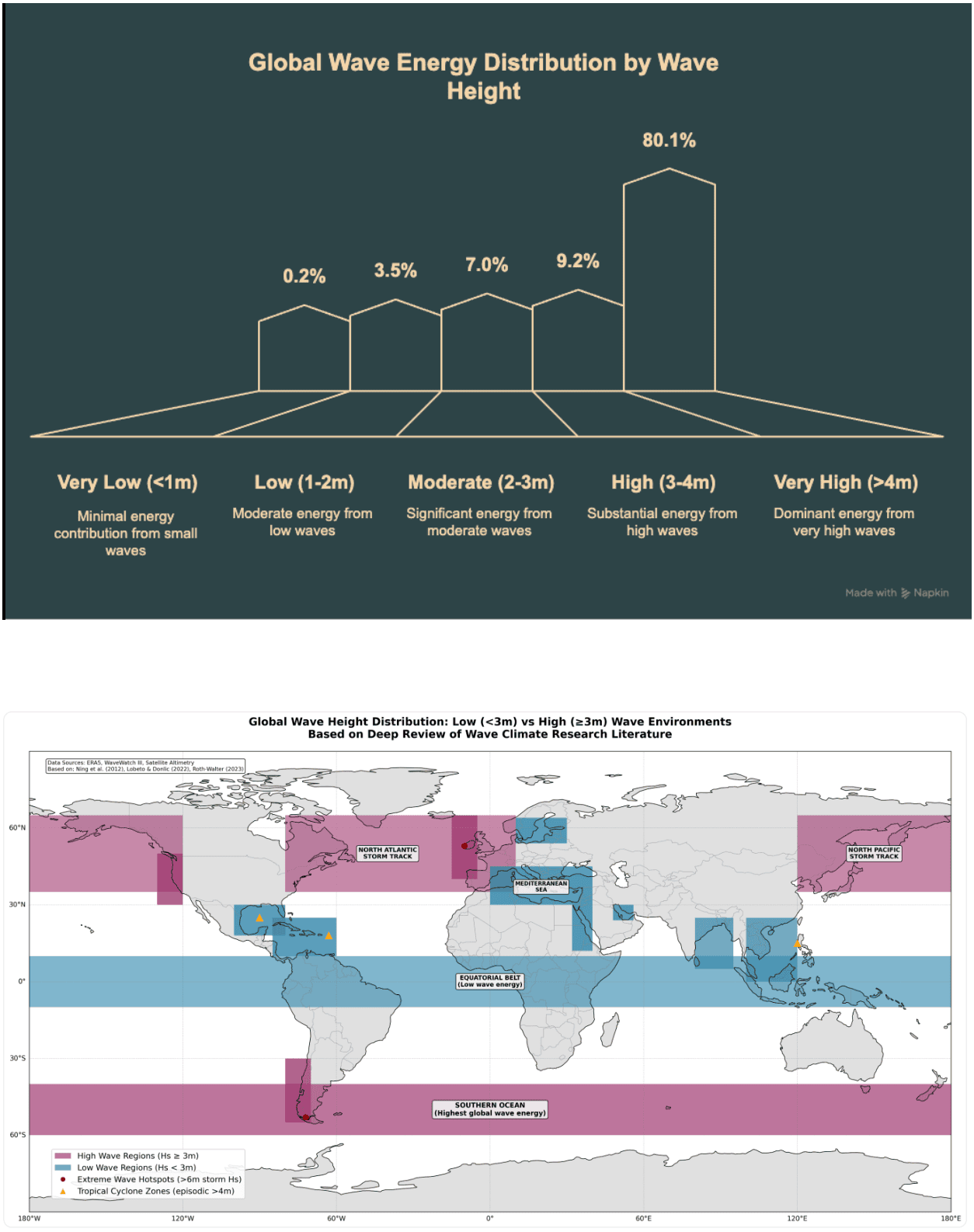
While the IPCC has broadly calculated wave energy potential to be in the region of 32,000 TWh, it is not evenly distributed around the world’s oceans and seas.⁹
The powerful waves may have attracted early pioneers, but these environments also offer the most challenging conditions, requiring extremely robust engineering and often expensive maintenance. High wave heights necessitate more costly solutions, accompanied by greater investment risks - see Figure 3—the Icarus effect, or perhaps more appropriately, the call of the Sirens in Homer’s Odyssey.
The powerful waves may have attracted early pioneers, but these environments also offer the most challenging conditions, requiring extremely robust engineering and often expensive maintenance. High wave heights necessitate more costly solutions, accompanied by greater investment risks - see Figure 3—the Icarus effect, or perhaps more appropriately, the call of the Sirens in Homer’s Odyssey.
A few have made significant strides, as I have outlined in the three earlier episodes—firms such as CorPower Ocean, Mocean Energy, and Seaturns. ZOEX Power, on the other hand, has found a way to harness low wave energy, which may prove to be a shrewd move.
Background to ZOEX Power
ZOEX Power was founded by Aslihan Penley, also known as Ash, who is of Turkish descent. She worked in the oil industry in Turkey, UK,Australia and the US before transition her skills to marine renewables, and location back to the UK, Edinburgh in 2017 to represent an Israeli wave energy company. After a stint at Eco Wave Power, she started her own company, Nomad Engineers, launched in 2019 following a SMART grant from Scottish Enterprise.
The shift from a career in fossil fuels was inspired by a desire to make her two children proud of her. Rather than move into established renewable energy areas like solar and wind, she decided to make her mark in wave energy, as she had experience in offshore oil and gas. The company’s name, ZOEX, was also inspired by the names of her children, Zoe and Alex. Adding to her MSC in chemical engineering, Ash Penley gained a Galileo Master’s Certificate from the European Energy Centre, as she transitioned to wave energy innovation. Using the grant from Scottish Enterprise and her own investment of £100,000, she hired experienced wave energy engineers from the University of Edinburgh and the University of Strathclyde to develop a prototype wave energy converter (WEC) in 2023.
She partnered with a Scottish engineering consultancy, Sealand Projects, to apply for funding to test the prototype. The Seafood Innovation Fund gave her £246,000, enabling the testing of the ZOEX at the Port of Aberdeen in 2024. Encouraged by the successful trials, ZOEX received a further investment of £531,000 in May 2025 from Innovate UK, angel investor Equity Gap, Scottish Enterprise, and the University of Strathclyde. This is used for longer sea trials off the Turkish coast, a small coastal town, booming with aquaculture fish farming, called Ordu, until the end of 2025. The system has proven 94% availability and its robustness in storms.
ZOEX WEC Technology is designed for off-grid, low wave height scenarios
Figure 4 shows three ZOEX WECs attached to a fish-feeder charge barge, along with a simple explanation of how they work. Figure 5 includes images from the Ordu sea trials.
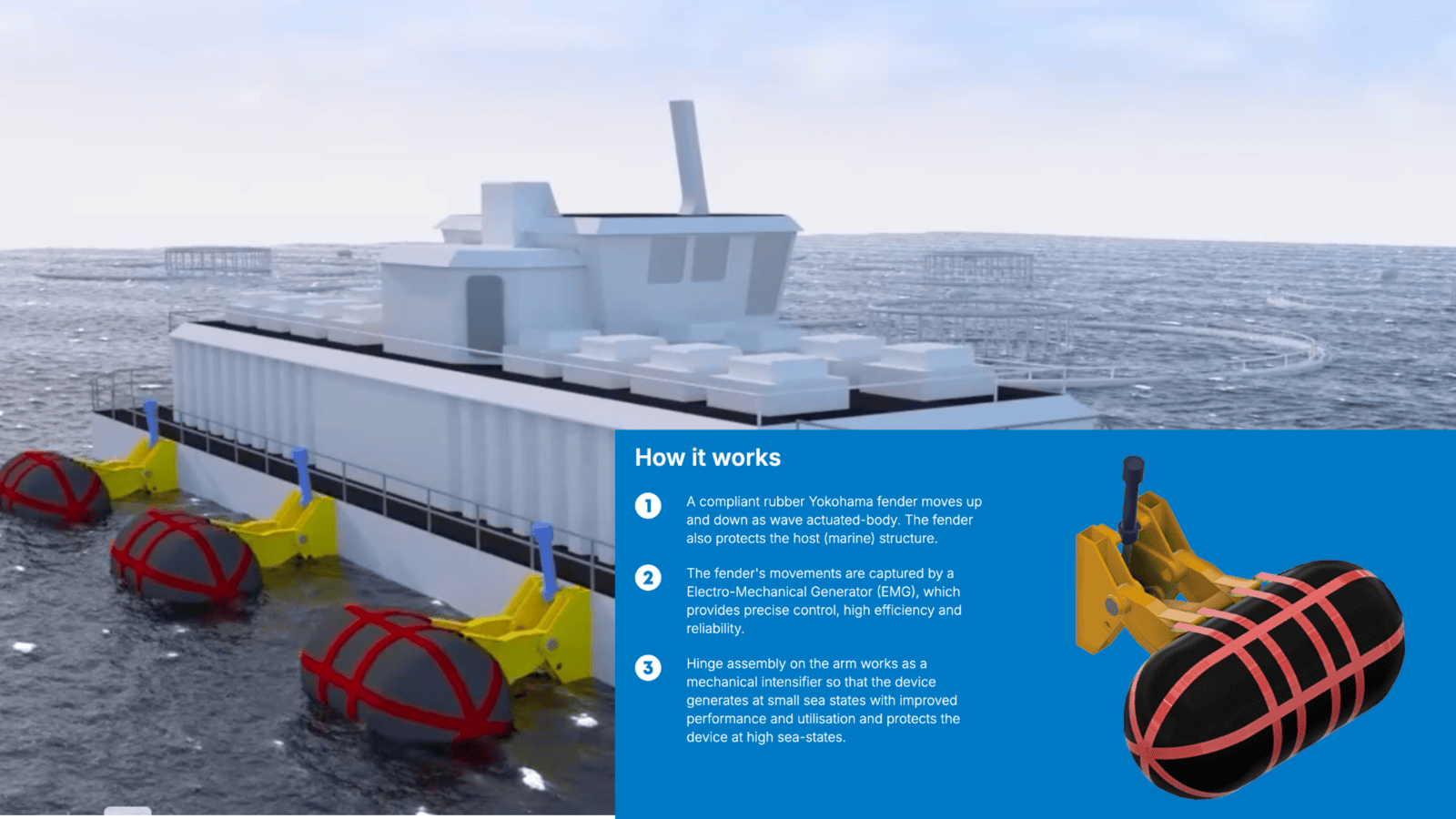
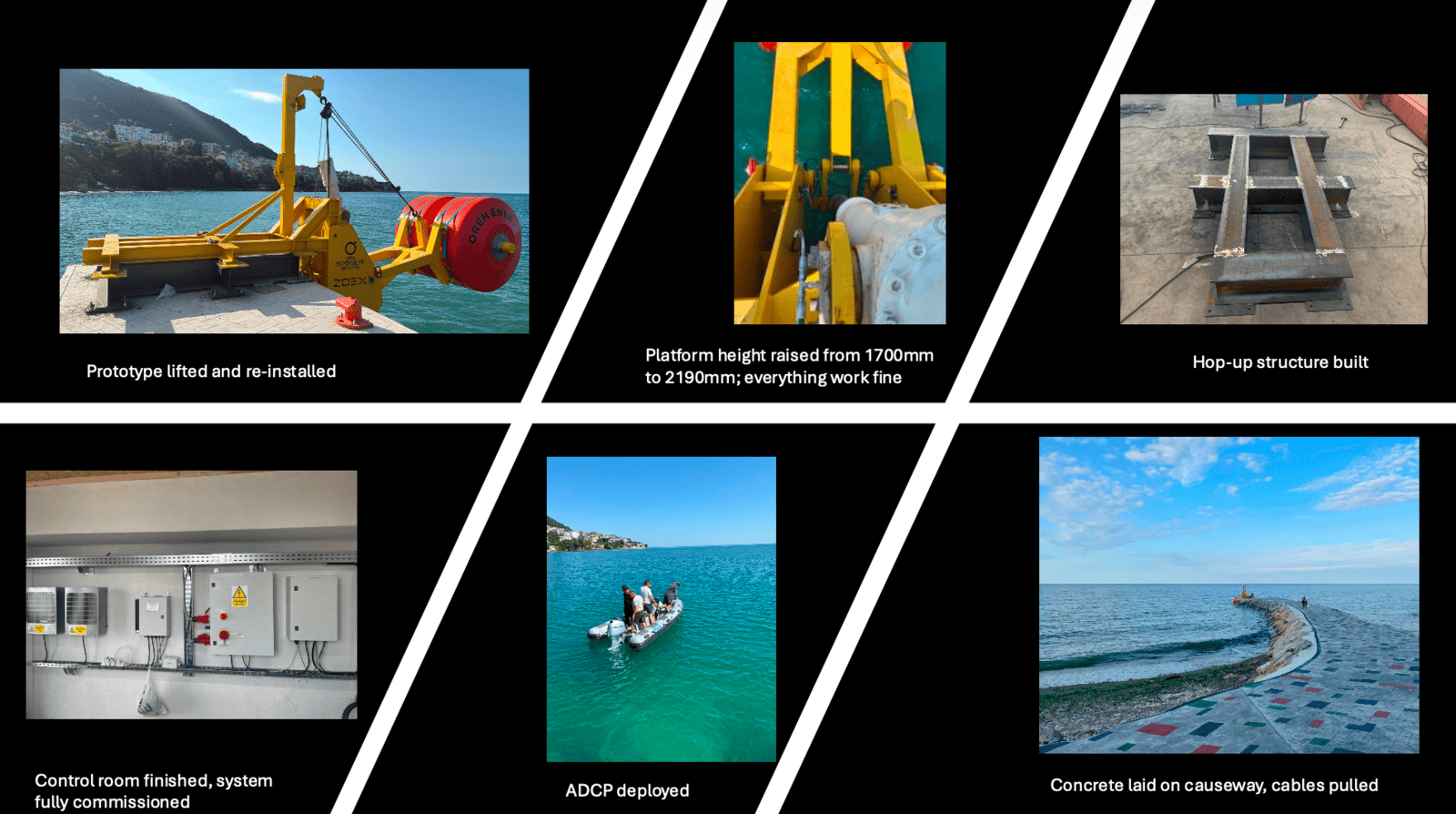
The main advantages of the ZOEX WEC are that it combines proven technology with a proprietary double-link arm mechanism, which amplifies the power of waves with relatively low heights (\<2mHs). Most other WECs require significantly higher wave heights to operate. ZOEX uses Umbra’s Ball Screw Power Take Off Device (PTO) and Yokohama fender. While the primary use case is in aquaculture, such as salmon farms operating in low Hs environments, it can be designed to survive storms up to 10 metres.
With a deliberate policy of not reinventing but leveraging proven technology, supplemented by its in-house innovation, the complete WEC solution can be deployed at a lower cost than many other WEC developers starting from scratch.
Most wave developers follow a path of proving their technology can export power to the grid. ZOEX, instead, has adopted a niche offshore power delivery strategy that can be replicated rapidly in relevant off-grid market segments. As we shall see, this doesn’t mean ZOEX lacks ambition, but rather that it has a smart, stealthy strategy to become the world’s first wave £Billion+ unicorn.
ZOEX Power adopts a classic bowling alley strategy to compete in the wave energy market
In 1991, Geoffrey Moore’s book Crossing the Chasm was published. It presented a more realistic portrayal of the Diffusion of Innovation hypothesis, as proposed by Everett Rogers in 1962, when applied to the adoption of technological innovations. Instead of a smooth bell-curve of adoption from innovators, early adopters, through to the mainstream buyer, he noticed that many technologies fizzled out. Appealing only to this small group of buyers, the more risk-averse and unconvinced early majority fails to take up the baton.
The current state of the wave energy ‘market’ means that if early adopters get their fingers burned, or are so niche that WEC developers can’t yield profitable growth, spooking investors, the market potential collapses. Moore noticed this tendency in the IT market and discerned that to reach the mass market opportunity, a technology provider must somehow ‘cross the chasm’ or fail. One way of doing that was to adopt what he called a bowling alley strategy.
First, identify a niche, then look for adjacent industries where, with only minor adjustments, there would be a good fit. This strategy not only increases the total available market for the solution but also minimises the innovation costs and accelerates market penetration.
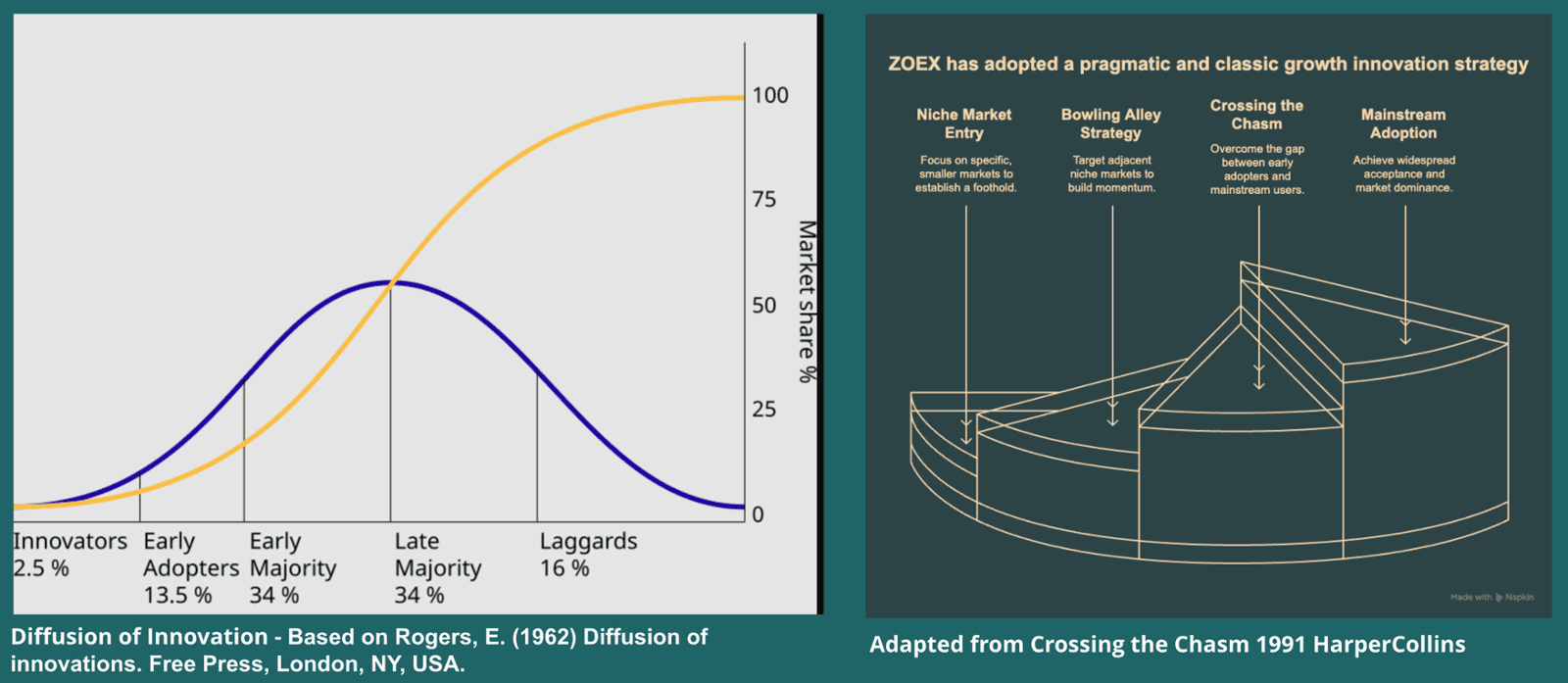
igure 5: Diffusion of Innovation + author’s interpretation of Crossing the Chasm, using wedge sizes as a proxy for greater returns and market maturity.
Ash Penley and her team appear to have adopted the bowling alley strategy. Having initially decided to target off-grid and offshore wave opportunities rather than succumb to the Sirens’ call, aiming at large-scale utility opportunities, ZOEX is targeting aquaculture fish farming. Once established, subsequent ‘bowling pins ‘ include O&G subsea infrastructure for carbon capture, displacement of diesel generators (as regulations continue to tighten), and storage-tech. The ZOEX Charge-barge approach, combined with a battery pack, should also appeal to the growing demand for IoT Marine data monitoring. Very little modification, if any, will be required to suit these different niches. Another potential market is subsea data centres. The need for ever more computing power and larger data centres to meet demand for AI has major IT providers concerned about escalating costs, not just of servers but also the cost to keep them cool. Firms like Microsoft, Google, Nautilus Data Technologies, Highlander and Subsea Cloud have projects to build underwater data centres to reduce cooling costs. All of these require renewable energy sources. Most are building their data centres near ports to avoid harsh marine environments. This could be a significant opportunity for ZOEX Power.
Apart from minimising the cost of innovation and adaptation, the ZOEX WEC attaches to existing offshore infrastructure, negating the need for lengthy and often bureaucratic planning requirements or the development of costly infrastructure. Once established in its chosen niches, ZOEX will leverage its evolving capabilities and expand into utility-scale markets, combining other renewable sources, such as hydrogen, to further build on its success. Little wonder, then, that Penley has set her sights on becoming the first wave energy unicorn.
ZOEX Power’s timeline - on the brink of commercialisation
The following timeline illustrates the progression of ZOEX Power and its anticipated position by the end of this decade.
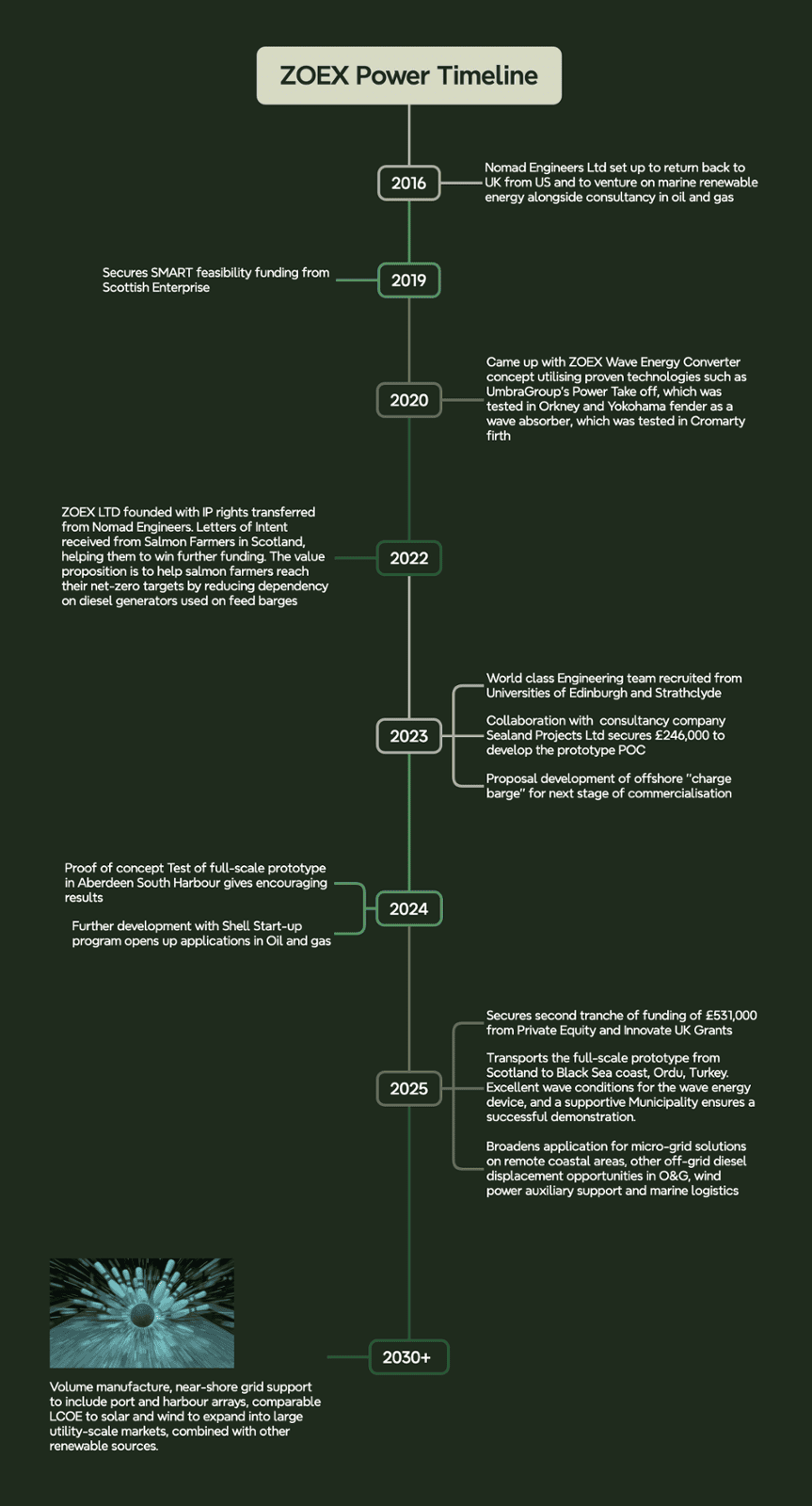
ZOEX Power’s advantages are significant and numerous
ZOEX’s strategy to gain traction in low-Hs environments before committing to utility-scale opportunities may prove to be a significant differentiator. While most wave pioneers compete for the utility-scale market, ZOEX has found a way to generate electricity from low-Hs environments. Its technology partnerships provide a mechanism for it to scale quickly. Investors will likely appreciate this news, and we can expect increased investment to be forthcoming soon. As confidence grows and the comparative levelised costs of electricity are reduced, ZOEX’s expansion into adjacent markets will accelerate.
Production costs are significantly lower than those of grid-facing wave energy providers, which rely on more complex engineering solutions. Not succumbing to the Siren call of utility-scale opportunities from the start may prove to be Ash Penley’s most brilliant decision.
